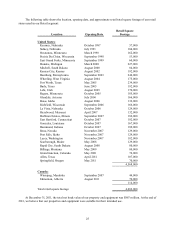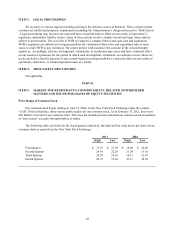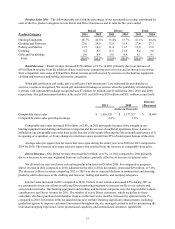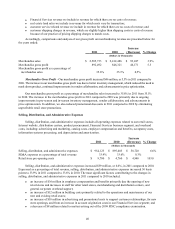Cabela's 2011 Annual Report Download - page 42
Download and view the complete annual report
Please find page 42 of the 2011 Cabela's annual report below. You can navigate through the pages in the report by either clicking on the pages listed below, or by using the keyword search tool below to find specific information within the annual report.
32
This system, along with our replenishment system, allows us to identify the correct product mix in each of
our retail stores, and also helps maintain the proper inventory levels to satisfy customer demand in both our
Retail and Direct business channels, and to improve our distribution efficiencies.
We intend to concentrate more resources behind this effort to help drive improvements to the customer
shopping experience even more quickly.
• Improve Merchandise Performance: Improve margins and minimize unproductive inventory by
focusing on vendors, assortment planning, and inventory management. Optimizing merchandise
performance allows us to maximize margins, which will require detailed preseason planning, as well
as in-season monitoring of sales and management of inventory. We must work with vendors to manage
inventory levels, negotiate the best prices on everything we buy, and ensure each vendor is delivering all
products and services as expected.
We continue to concentrate our efforts in detailed pre-season planning, in-season monitoring of sales, and
management of inventory to focus product assortment on our core customer base. We also continue to
work with vendors to negotiate the best prices on products and to manage inventory levels, as well as to
ensure vendors deliver all products and services as expected. We reduced promotional discounts in 2011
compared to 2010 by eliminating unprofitable retail store promotions. As a result, our merchandise gross
margin as a percentage of merchandise revenue increased 50 basis points to 35.6% in 2011 compared to
35.1% in 2010. This increase was attributable to better inventory management, which reduced the need to
mark down product, improvements in vendor collaboration, and advancements in price optimization to
ensure we are pricing correctly in the marketplace.
We are working on optimizing the interactions between our merchandising and inventory groups and
marketing to provide our customers with the products they want, when they want them, while improving
gross margin performance.
• Retail Profitability: Improve retail profitability by concentrating on sales, advertising, and costs while
providing excellent customer experiences. Our goal is to identify the best practices that produce the best
results and apply those findings to all of our retail stores. We have to execute on the balance that allows
us to deliver the best possible selection of products and expected level of customer service in each store
while managing labor, advertising, and other store costs.
We have improved our retail store merchandising processes, information technology systems, and
distribution and logistics capabilities. We have also improved our visual merchandising within the stores
and coordinated merchandise at our stores by adding more regional product assortments. To enhance
customer service at our retail stores, we have increased our staff of outfitters and have continued our
management training and mentoring programs that we implemented in 2010 for our next-generation store
managers. Comparing Retail segment results for 2011 to 2010:
• operating income increased $57 million, or 27.8% (including a $33 million increase in the
marketing fee paid by the Financial Services segment),
• operating income as a percentage of Retail business segment revenue increased 240 basis points
to 17.0%, and
• comparable store sales increased 2.8%.
• Retail Expansion: Capitalize on our brand strength by developing a profitable retail expansion strategy
focused on site locations and appropriate sized stores in our top markets. Our goal is to increase our retail
presence across the United States and Canada by developing a profitable retail expansion strategy that
takes into consideration not only site location, but also the strategic size for each store in its given market.
We incorporated our next-generation store format into our three new stores that we opened in 2011
bringing our total retail store square footage to 4.7 million square feet at the end of 2011. We have
also developed a new Outpost store format which will be approximately 40,000 square feet in size and
have a “core-flex” merchandise strategy (selected core assortment of products and flexible seasonal
merchandise) that will allow us to effectively serve smaller markets with a large concentration of Cabela’s
customers. We have announced plans to open five next-generation stores in 2012: Wichita, Kansas;
Tulalip, Washington; Rogers, Arkansas; Charleston, West Virginia; and Saskatoon, Saskatchewan,
























